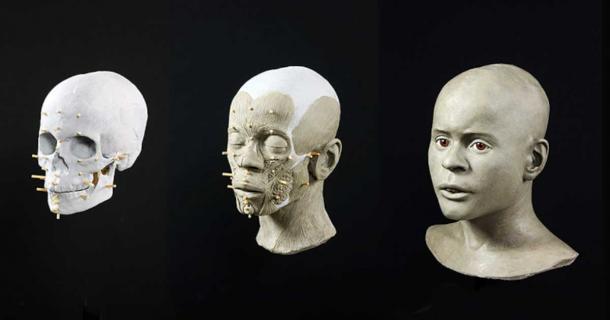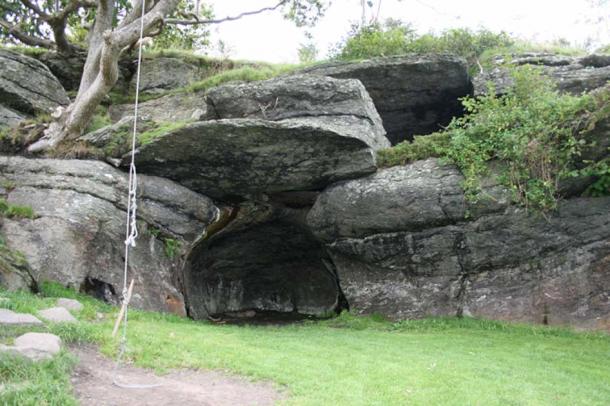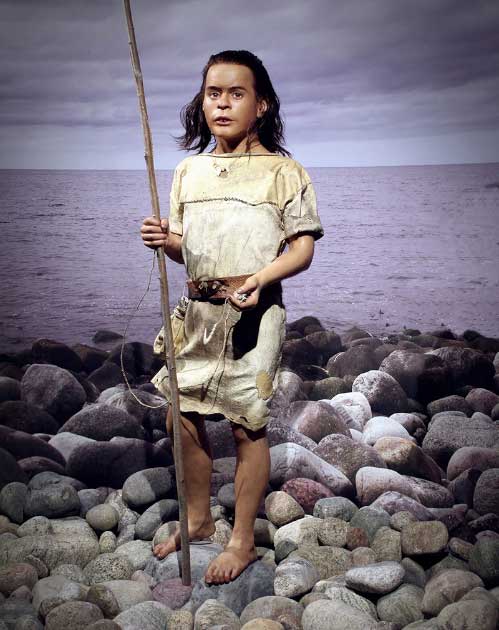In 1907, the remains of a teenage boy who lived over 8,300 years ago were discovered in a Mesolithic cave located in Randaberg on the west coast of Norway. Dubbed as “one of the oldest skeletons ever found in Norway,” the fascinating reconstruction of the boy, known as Vistegutten, has recently been unveiled at the Hå Gamle Prestegard Museum .
Using a novel reconstruction technique, this work has breathed new life into the 15-year-old who has been remembered for having an “unusual skull.” The reconstruction has also provided a glimpse into the life of a Stone Age teenager and contributed to our understanding of the region’s history.

Vistegutten’s skeletal remains were found in a cave once used by Mesolithic hunter-gatherers. The teenager’s skeleton on display at the Archaeological Museum in Stavanger. (Terje Tveit / The Museum of Archaeology / University of Stavanger / CC BY-SA 3.0 )
Using Artificial Intelligence to Reconstruct the Face of Vistegutten
Vistegutten, or “the boy from Viste,” was short for his age and era, standing at only 4 feet 1 inches (125 cm) tall. He also had a condition known as scaphocephaly, which caused his skull to grow backward instead of sideways, giving him an unusual appearance. He did not suffer from any kind of developmental disorder or intellectual disability, and was a healthy boy, all things considered.
“Either he was placed like this after his death, or he actually died in this position,” explained the Swedish forensic artist Oscar Nilsson, who created the boy’s likeness. “This can give the impression of a lonely boy, waiting in vain for his friends and family to show up… but we know nothing about how he died,” said Nilsson in an email exchange with Live Science .
Artificial Intelligence (AI) art has recently been doing the rounds in the visual arts sphere, but in the recent past historians and archaeologists have been using it to reconstruct historical figures and faces. This has come in particularly handy where the recovered evidence has not been sufficient to follow traditional reconstruction techniques, as in the case of Vistegutten.

The forensic artist Oscar Nilsson invested many months in creating the reconstruction of Vistegutten based on the boy’s skull. ( Oscar Nilsson )
Reconstruction Uses Artistic Judgment to Create Vistegutten’s Face
For instance, a few months ago, a team of Swedish coroners and artists worked together to reconstruct the face of a 4,000-year-old Stone Age woman , while a man who lived 8,000 years ago had his face reconstructed previously. Recently, researchers attempted to reconstruct the face of a woman who was thought to be a man, reports Science Post .
Nilsson has previously worked on other facial reconstructions of ancient individuals. The work done to reconstruct the face of Vistegutten provides a glimpse into what this Stone Age teenager may have looked like and allows modern viewers to connect with a human who lived thousands of years ago.
Nilsson also noted that the teenager’s lower jaw was smaller than average, and his teeth were in relatively good condition. The boy’s hair color, eye color and skin tone are unknown, so Nilsson used his artistic judgment to make a “neutral and believable” face that wouldn’t look out of place in the museum exhibit. The reconstruction shows the boy with short, curly hair and a serious expression, his head tilted slightly downward as if in contemplation.
The boy’s remains were found leaning against a cave wall, leading some to speculate that he died alone. However, there is no evidence to support this theory and it is not known for certain how he died. One such theory suggests that his death was rather tragic, with speculation that he lost his balance as he was clutching a fishing rod.

The remains of the teenage boy known as Vistegutten was found in a cave in western Norway (Jarvin Jarle Vines / CC BY-SA 3.0 )
Vistegutten’s Final Resting Place Offers Glimpse of Mesolithic Life
The boy’s physique and the remains at the site suggest that food was aplenty. “The sheer volume of animal remains found at the site also attests to a plentiful food supply,” said Sean Dexter Denham, an osteologist at the Museum of Archaeology at the University of Stavanger in Norway who helped analyze the skeleton.
The cave is filled with evidence of ancient human activity, including kitchen waste, bone ornaments, and various fishing tools such as hooks, harpoons, and barbed bone points. This suggests that the cave was a site of human habitation and activity, where people lived, worked, cooked and slept.

The forensic artist paid a lot of attention to details to truly bring Vistegutten to life. ( Oscar Nilsson )
The artifacts found in the cave offer a glimpse into the daily lives and practices of ancient humans in the Mesolithic era. For example, the presence of fishing tools suggests that fishing was an important source of food for the people who lived in the cave. The bone ornaments, on the other hand, suggest that these people had a sense of aesthetic appreciation and may have used personal adornments as a means of self-expression or social status.
Once again, advanced facial reconstruction has provided a window into ancient history, this time into the world of the Norwegian boy known as Vistegutten. All in all, the discovery of both the cave and the child are a reminder that people in the past were very much like people in contemporaneous times, even though they inhabited a world that was very different from the modern one. Meanwhile his facial reconstruction allows us to come face-to-face with Vistegutten in a way that wasn’t possible before.
Top image: Facial reconstruction of Vistegutten by forensic artist Oscar Nilsson. Source: Oscar Nilsson
By Sahir Pandey
 RSS Feed
RSS Feed















 February 18th, 2023
February 18th, 2023  Awake Goy
Awake Goy  Posted in
Posted in  Tags:
Tags: 













